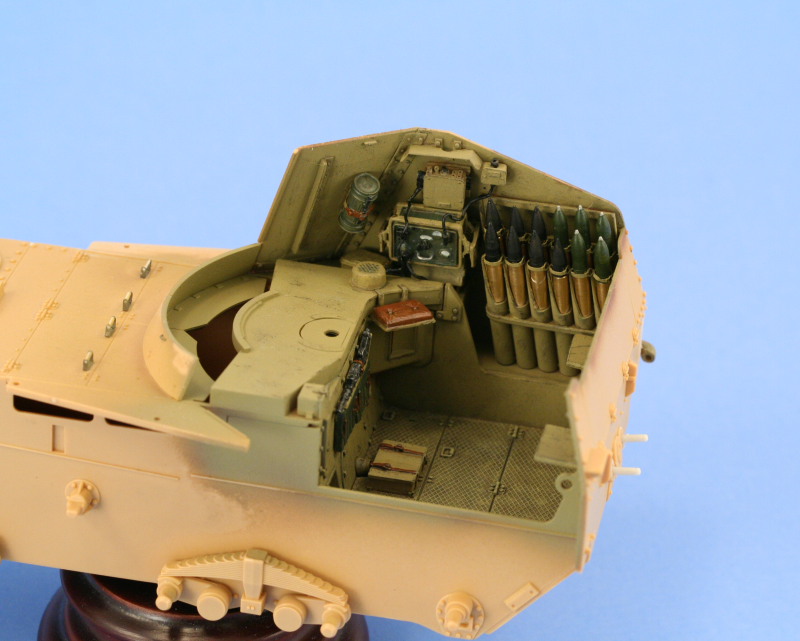With the fighting compartment fully assembled, the next step was to take care of the plate join seams on the exterior. Reference photos show these areas to be smooth with the rivets attaching the one-piece angled plates to the braces on the interior. This is a tricky thing to accomplish due to how close together the rivets are, so I used the point of a wooden toothpick to sparingly apply some Squadron White putty into the seam line and preserve the rivets. On the angled surfaces, a toothpick with a section of hobby sanding film glued to it with CA gel allowed for some sanding and smoothing on the larger gaps.
The kit fenders were used instead of the Eduard items. I went through the whole drill of building up the right side fender only to discover that the front brace is about 2mm too short to allow the fender to sit properly and mate up with the hull. This, combined with the surgery necessary on the kit supplied fenders meant that the Eduard set was put off to the side.


My attention then turned to the hull details for the pioneer tools and other fittings. My first step was to fit the large handles to the base of the gun shield and replace all of the lost tarp securing loops that had been knocked off in previous steps. The large handles were installed first and then the PE loops afterward to minimize the amount of handling in that area.
Next up came the spare track holders for the glacis and hull front. These provide much better detail than the kit supplied items, which are on the thick side, but are an exercise in patience due to the fact that the central "spine" is a separate PE piece and there's very little surface area to hold it in place. A small groove is etched into the base part, but it still requires care in getting it lined up and secured properly.
I also replaced the kit supplied Notek light hood with a combination of the Eduard PE base and the Blast supplied hood. The hood required some minor sanding to remove a crease on the top as well as smooth out the nub left by the pouring block, but otherwise went smoothly as it's designed to fit the kit supplied mount post.
I carefully constructed and installed the gun travel lock mechanism to allow it to remain fully workable to ease in painting and detailing. To accomplish this, do not apply any glue to parts G60, G62, and G63 where the lock, part G60 touches them.
The left fender also received attention for its PE tool clamps in place of the kit molded on items. The left fender has large open mounting holes in it originally intended to take the mount posts on the grouser box and axe, so these needed to be blanked over to prevent daylight peeking through. I applied some strips of 0.3mm sheet styrene and then sanded them down with a coarse sanding twig. I did this instead of using putty due to the large diameter of the holes and the need to have them blanked off both top and bottom from view.

Once that was done, I proceeded to fit the PE clamps for the barrel cleaning rods on the upper sponson along with the axe clamps on the fender itself. I replaced the kit grouser box with the Eduard PE and used the Blast included jack with the kit styrene handle, part G54, mated to it. The Blast jack was two parts and required some flash trimming and clean-up to get it presentable, but was worth it in the detail department. The grouser box was carefully positioned to allow sufficient clearance for the jack and then glued in place using liquid glue to get a solid join to the hull side before the jack was secured with CA gel.

Next up will be the right side tool clamps, then the details on the rear hull and it will be ready for painting the exterior.








































